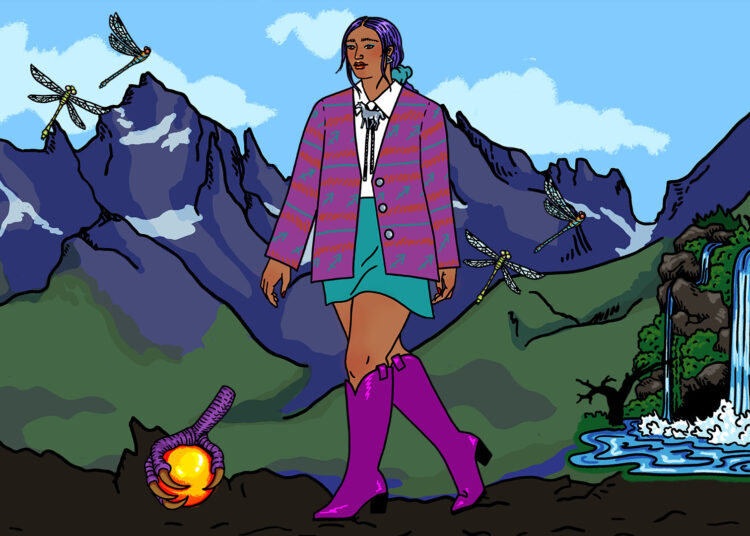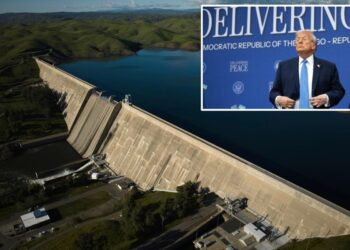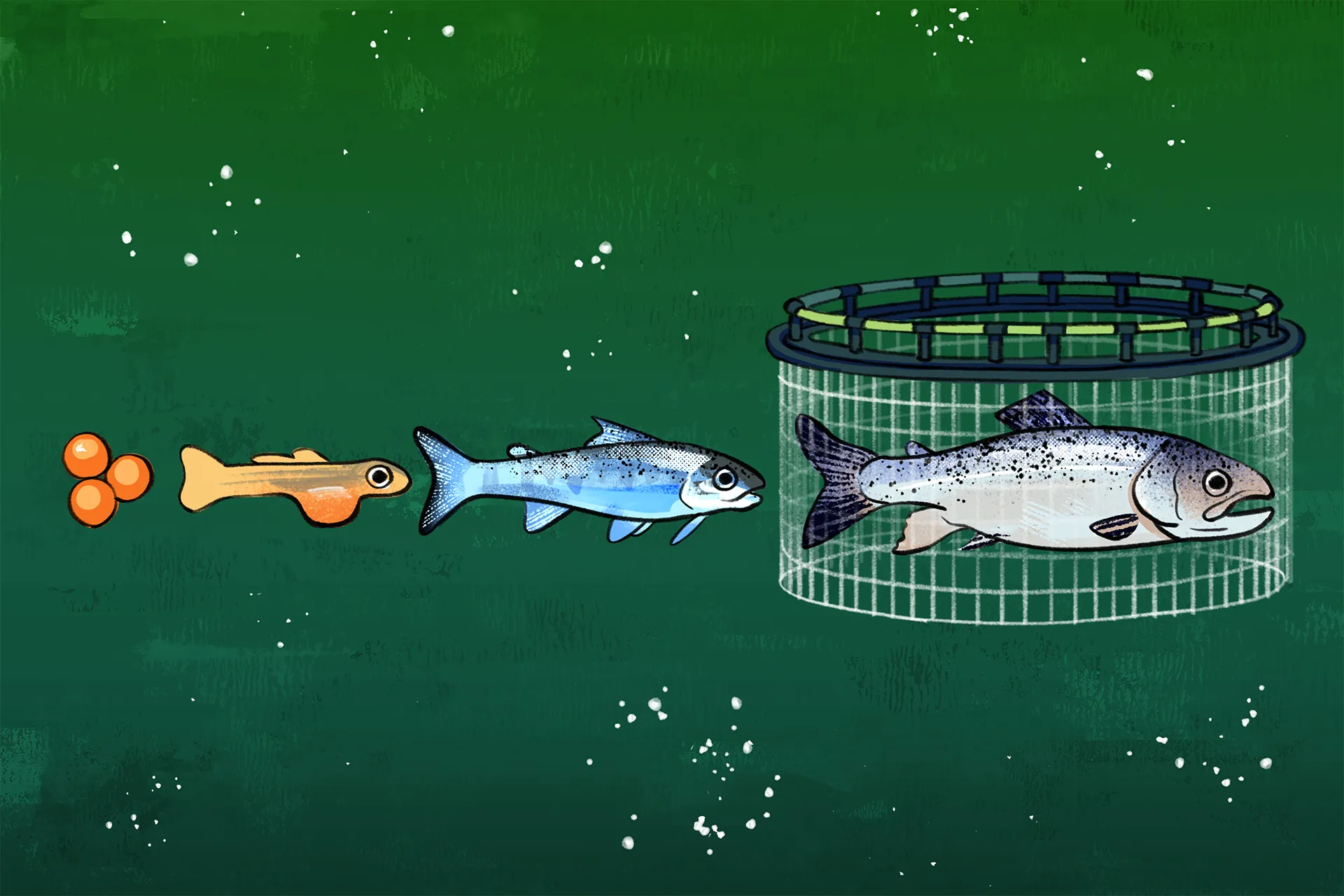
This story is part of a series supported by Animal Charity Evaluators, which received a grant from EarthShare.
The last few decades have seen, arguably, the most sweeping transformation in how humans produce meat, and it has nothing to do with chickens, pigs, or cows. It has to do with fish.
Inside this story
- Over half of the world’s seafood now comes from fish farms, which resemble underwater factory farms.
- Chickens, pigs, and cows were domesticated over thousands of years, but fish have been domesticated in under a century. It’s created serious welfare issues, especially for salmon.
- Salmon are carnivorous and migrate thousands of miles. On farms, they’re reduced to swimming in small tanks and eating pellets.
- Fish farming has taken over the seafood sector, but some experts argue that it’s moved too fast, and we need to better understand welfare issues.
Traditionally, the vast majority of fish that people consume has come from the ocean. But in 2022, humanity hit a significant milestone: Seafood companies began to raise more fish on farms than they caught from the sea. And they farm astonishingly large numbers of fish — in tiny, cramped enclosures that resemble underwater factory farms.
It amounts to the fastest and largest animal domestication project that humanity has ever undertaken.
For most of the land animals we eat today, domestication — or, as French fish researcher Fabrice Teletchea defined it, the “long and endless process during which animals become, generations after generations, more adapted to both captive conditions and humans” — has taken place over thousands of years. “In contrast,” a team of marine biologists wrote in the journal Science in 2007, the rise of fish farming “is a contemporary phenomenon,” taking off on a commercial scale around the 1970s.
By the early 2000s, humans were farming well over 200 aquatic animal species, virtually all of which had been domesticated or forced into unnatural conditions in extreme captivity over the course of the previous century, with many in just the prior decade. To put it another way, the marine biologists wrote, aquatic domestication occurred 100 times faster than the domestication of land animals — and on a vastly larger scale. Today, some 80 billion land animals are farmed annually, while an estimated 763 billion fish and crustaceans are farmed each year, a figure projected to quickly grow in the decade ahead.
What’s more, this attempt to speedrun domestication occurred even as a clear scientific consensus emerged in recent decades that fish can suffer and feel pain.
The revolution in how humans produce seafood has enormous implications for our relationship with species we’ve barely given any thought to. To understand why, consider America’s favorite fish to eat, and one of the most difficult to farm: salmon.
Like farming tigers
Salmon farming is a relatively new industry, and it emerged largely in response to manmade problems.
Over the last century, overfishing — combined with industrial pollution, climate change, and heavy damming — has decimated wild Atlantic salmon populations. By 2000, the species gained protection under the Endangered Species Act after it was nearly driven to extinction in the US, effectively banning the commercial fishing of Atlantic salmon.
Salmon populations in Europe, along with Pacific salmon populations on the West Coast of the US and beyond, have also experienced significant declines.
To take pressure off depleted wild populations, seafood producers began to scale salmon farming in the 1970s, with ample help from governments in the form of R&D, grants, state financing programs, and more. It’s proven to be a smashing commercial success.

 Last year, salmon farming companies — which are most concentrated in Norway, Chile, and the UK and export their product around the world — produced 2.8 million metric tons of the fish, or around 560 million individual salmon. They’re typically raised in tanks on land until they’re a year old then transferred to nets and cages floating in the ocean just offshore to be fattened up and eventually slaughtered (they’re supposed to be rendered unconscious prior to slaughter, with either electric stunning or a club to the head, though some aren’t successfully stunned).
Last year, salmon farming companies — which are most concentrated in Norway, Chile, and the UK and export their product around the world — produced 2.8 million metric tons of the fish, or around 560 million individual salmon. They’re typically raised in tanks on land until they’re a year old then transferred to nets and cages floating in the ocean just offshore to be fattened up and eventually slaughtered (they’re supposed to be rendered unconscious prior to slaughter, with either electric stunning or a club to the head, though some aren’t successfully stunned).
About one out of every five are shipped off to the US, where “young affluent consumers love to eat salmon,” according to the Norwegian company Mowi, the world’s biggest salmon producer.
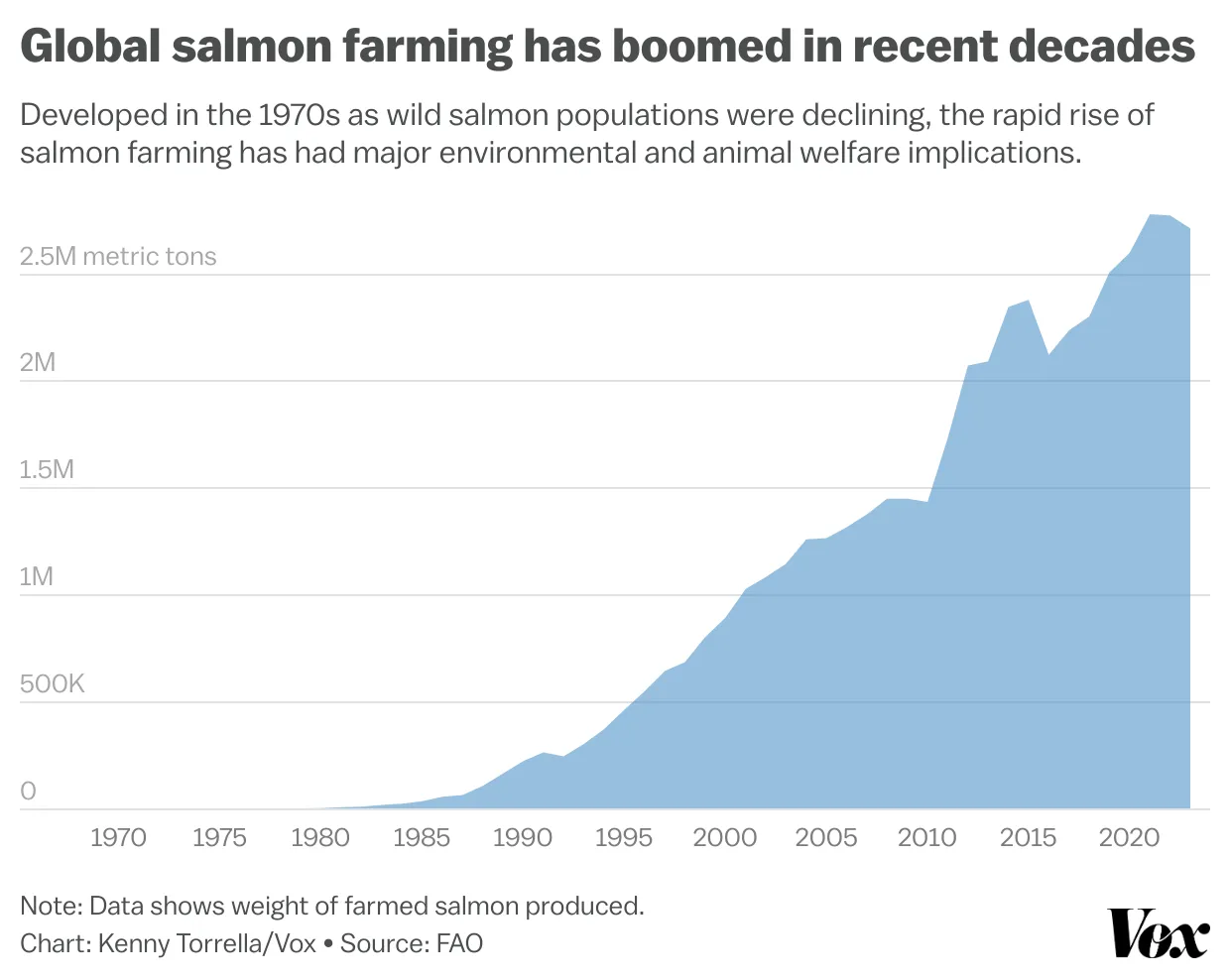
This taste for salmon and the farming industry it has necessitated has, in just a few generations, dramatically transformed what it means to be a salmon. In the wild, salmon live incredibly complex lives and embark on epic journeys. But on farms, they can’t do any of that.
According to Becca Franks, an assistant professor of environmental studies at New York University, salmon farming has created grave welfare problems by denying the animals the ability to engage in two of their essential natural behaviors: migrating and hunting.
In the US, Atlantic salmon begin their lives as eggs buried a foot under freshwater riverbeds in Maine, where they remain for six months until they hatch and emerge in search of food. At a few years old, they migrate hundreds of miles northward into the salty Atlantic ocean, then hundreds of miles further out into the Labrador Sea, near Greenland. There, they quickly put on weight — feeding on krill, herring, and crustaceans — which they’ll need for the long journey home that they make after a couple years of dining out at sea.
Following scents and using the earth’s magnetic field, Atlantic salmon swim over 1,000 miles back to their home streams to spawn the next generation.
The salmon’s life cycle inspires more awe and reverence than most species in the animal kingdom, but on farms, they’re reduced to swimming in tiny circles for years and subsisting on small, manmade pellets. Their “welfare is harmed through loss of agency and choice,” Franks told me in an email. She likens salmon farming to trying to farm tigers.
Sophie Ryan, CEO of the Global Salmon Initiative — a coalition of salmon farming companies — challenged the idea that domestication has harmed salmon. “They have been domesticated over more than 50 years — similar to cattle or poultry — and have been selectively bred to thrive in a farm environment,” Ryan told me in an email. “Their nutritional needs, swimming patterns, and energy use are different from wild salmon, because their environment and purpose are different.”
The selective breeding that Ryan speaks of has been used to make farmed salmon grow twice as fast as their wild counterparts, which has led to a number of serious health issues: heart problems, spinal deformities, high levels of deafness, and increased risk of an early death. They’re also more aggressive than wild salmon.
To boost growth even further, salmon farms keep their lights on up to 24 hours a day, which makes the fish eat more and can damage their retinas.
And in a concerning twist, the domestication of farmed salmon is hurting wild salmon. Since the 1970s, tens of millions of farmed salmon have managed to escape and compete for resources with wild salmon and even mate with them, leading to “genetic pollution” that has resulted in a hybrid line of salmon.
“We may now need to recognize a new biological entity — Salmo domesticus,” biologist Mart Gross wrote in a 1998 paper, “and treat it as an ‘exotic’ when it escapes into the wild.”
Some research has found that these hybrid fish have lower survival rates. That means that the farming of salmon, which was intended to give wild salmon populations a break, created a new challenge for them.
“Escape prevention is a top priority, with ongoing improvements in net strength, mooring systems, and real-time digital monitoring,” Ryan of the Global Salmon Initiative said. “Where escapes do occur, companies are required to report them and work with regulators to assess potential impacts on wild populations.”
Franks considers fish farming a form of “captive dewilding”: the process of modifying animals to conform to captivity and to the harms that befall them as a result. And the reality of that captivity can be incredibly cruel.
Fish farms up close
In 2019, animal rights activist Erin Wing worked undercover with the group Animal Outlook for four months at a salmon hatchery in Maine operated by Cooke Aquaculture, one of the world’s largest salmon farming companies. Wing documented workers culling diseased fish by hitting them against the sides of tanks multiple times; fish thrown into buckets still alive, left to suffocate or be crushed to death by other fish; fish born with spinal deformities; and fish dying from nasty fungal diseases that ate away parts of their faces.
“Over the years, you kinda get desensitized,” one employee told her.
In response to Wing’s investigation, Cooke Aquaculture CEO Glenn Cooke said in a statement that the company would re-train employees at the Maine facility. “We place animal welfare high in our operating standards and endeavor to raise our animals with optimal care and consideration of best practice,” Cooke said, adding that “what we saw today is most certainly not reflective of these standards.”
Wing, who has spent her career investigating factory farms, is skeptical of industry standards. “There are these [animal welfare] industry standards that are in place, and there are these guidelines, but at the end of the day, there’s not really any enforcement,” Wing told me. “So these farms will make up whatever rules they want that will work for them, for their workers, and then they’ll operate as they see fit. And that usually results in a lot of these animals suffering needlessly.”
Some of the suffering stems from putting farmed animals in the ocean, as crowding hundreds of thousands of salmon together in open waters attracts sea lice — tiny, painful parasites that feed on the salmon’s skin and can even kill them. In 2023, almost 17 percent of Norwegian farmed salmon died before they could be slaughtered for meat, largely from infectious diseases and injuries.
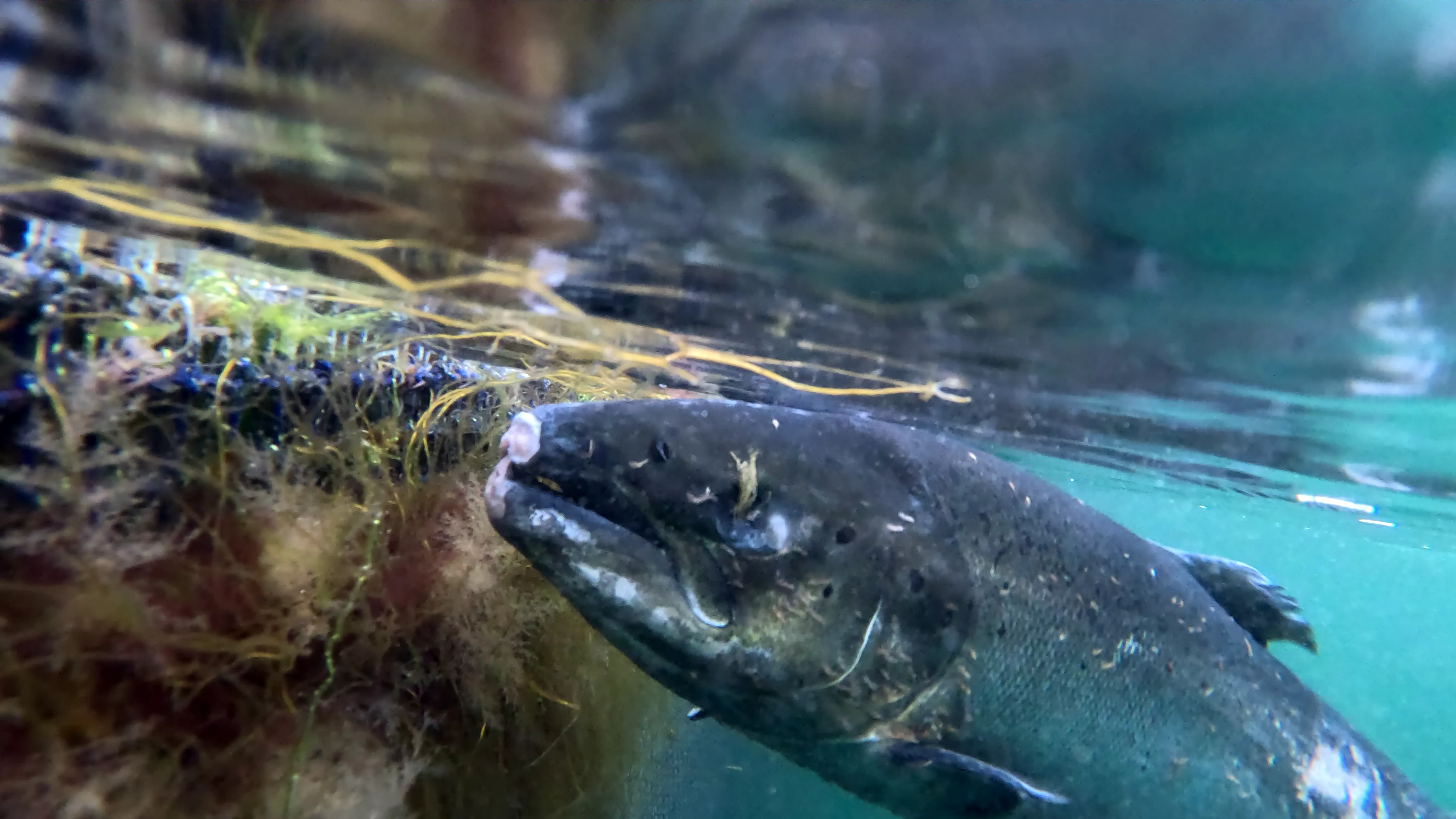
To combat the scourge of sea lice, salmon farmers had, for years, dumped chemicals into the water to kill them, along with antibiotics and other chemicals to protect the fish from a range of fungal and viral diseases. These pollutants, combined with vast amounts of animal waste generated by the salmon, fall to the ocean floor and pollute marine ecosystems.
That, in turn, contributes to what Franks calls “environmental dewilding,” or the process of modifying natural water bodies with artificial infrastructure — in this case, fish farm pens and cages — and polluting them.
Sea lice have since developed resistance to these chemicals, so, over the last decade, salmon farmers have switched to other methods — including subjecting salmon to high heat — which can cause pain, injuries, and death.
The International Salmon Farmers Association and the Global Seafood Alliance didn’t respond to interview requests.
Not just salmon
If we accept that farming salmon is bad for them and the environments in which they’re raised — and that we should protect dwindling wild populations — then we’ll have to accept eating a lot less salmon. We’ll also have to reconsider the ethical implications of farming many other fish species.
Fair Fish, a team of fish welfare researchers, has compared the natural behavior and welfare needs of nearly 100 fish species with the conditions they experience on farms. Out of the 100 analyzed species, only two — tilapia and carp — have “the potential to be farmed in somewhat decent conditions,” according to João Saraiva, who researches fish ethology at the Centre of Marine Sciences in Faro, Portugal, and runs the nonprofit Fish Etho Group. But that doesn’t mean that they actually are; both tilapia and carp farms tend to be overcrowded, with poor water quality and high rates of disease. (Saraiva has worked with Fair Fish on its analyses but is no longer involved in the project.)
By contrast, he said, salmon is “way down on the list,” meaning it’s especially hard for farms to meet their basic welfare needs.
Fair Fish’s research demonstrates how little attention the fish farming industry, and the governments that helped it take over the seafood sector, has paid to the simple question of how its captives experience being farmed. It also illustrates the damage we can do when we flatten “fish” — an incredibly diverse group of species — into a monolith.
Franks said industry and government need to pump the brakes on the expansion of fish and crustacean farming, which is currently the world’s fastest-growing agricultural sector, noting, “I think we should not be farming any new species of fish or crustaceans and putting in transition programs for folks already farming those species to move towards seaweeds and bivalves.” The latter is a class of invertebrate animals that includes scallops, oysters, and mussels, which Franks said have far fewer environmental and welfare concerns than farmed fish and crustaceans (whether bivalves are sentient or can feel pain remains an ongoing scientific debate).
She’s one of the few academics studying fish farming willing to go there, to suggest that we ought to fundamentally rethink how we produce seafood and how much of it we consume. “I think there is a huge reluctance to even broach the possibility of shifting diets away” from animal protein, said Franks.
When the global fish farming boom took off, many in the field had good intentions, and it looked good on paper; a way to boost the global food supply without further exploiting oceans. Plus, fish tend to have a lower carbon footprint than farmed land species (though higher than plant-based proteins). But few questions were asked about what it would mean, ethically and environmentally, to rapidly domesticate, then confine and slaughter, hundreds of billions of animals annually with distinct needs — let alone the capacity to feel pain.
Researchers like Saraiva and Franks are trying to convince the world to catch up with what we now know about fish and to further expand our knowledge. As consumers, we can help, and we can start by thinking twice about the salmon on our plates.
The post What we’ve done to the salmon appeared first on Vox.

